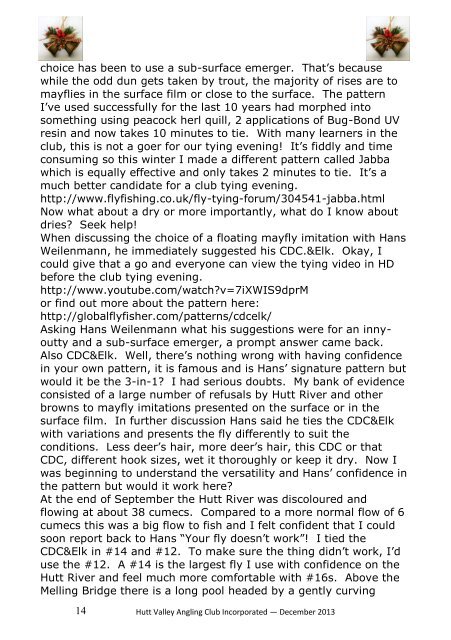Hutt Valley Anglers Club - New Zealand Federation of Freshwater ...
Hutt Valley Anglers Club - New Zealand Federation of Freshwater ...
Hutt Valley Anglers Club - New Zealand Federation of Freshwater ...
You also want an ePaper? Increase the reach of your titles
YUMPU automatically turns print PDFs into web optimized ePapers that Google loves.
choice has been to use a sub-surface emerger. That’s becausewhile the odd dun gets taken by trout, the majority <strong>of</strong> rises are tomayflies in the surface film or close to the surface. The patternI’ve used successfully for the last 10 years had morphed intosomething using peacock herl quill, 2 applications <strong>of</strong> Bug-Bond UVresin and now takes 10 minutes to tie. With many learners in theclub, this is not a goer for our tying evening! It’s fiddly and timeconsuming so this winter I made a different pattern called Jabbawhich is equally effective and only takes 2 minutes to tie. It’s amuch better candidate for a club tying evening.http://www.flyfishing.co.uk/fly-tying-forum/304541-jabba.htmlNow what about a dry or more importantly, what do I know aboutdries? Seek help!When discussing the choice <strong>of</strong> a floating mayfly imitation with HansWeilenmann, he immediately suggested his CDC.&Elk. Okay, Icould give that a go and everyone can view the tying video in HDbefore the club tying evening.http://www.youtube.com/watch?v=7iXWIS9dprMor find out more about the pattern here:http://globalflyfisher.com/patterns/cdcelk/Asking Hans Weilenmann what his suggestions were for an innyouttyand a sub-surface emerger, a prompt answer came back.Also CDC&Elk. Well, there’s nothing wrong with having confidencein your own pattern, it is famous and is Hans’ signature pattern butwould it be the 3-in-1? I had serious doubts. My bank <strong>of</strong> evidenceconsisted <strong>of</strong> a large number <strong>of</strong> refusals by <strong>Hutt</strong> River and otherbrowns to mayfly imitations presented on the surface or in thesurface film. In further discussion Hans said he ties the CDC&Elkwith variations and presents the fly differently to suit theconditions. Less deer’s hair, more deer’s hair, this CDC or thatCDC, different hook sizes, wet it thoroughly or keep it dry. Now Iwas beginning to understand the versatility and Hans’ confidence inthe pattern but would it work here?At the end <strong>of</strong> September the <strong>Hutt</strong> River was discoloured andflowing at about 38 cumecs. Compared to a more normal flow <strong>of</strong> 6cumecs this was a big flow to fish and I felt confident that I couldsoon report back to Hans “Your fly doesn’t work”! I tied theCDC&Elk in #14 and #12. To make sure the thing didn’t work, I’duse the #12. A #14 is the largest fly I use with confidence on the<strong>Hutt</strong> River and feel much more comfortable with #16s. Above theMelling Bridge there is a long pool headed by a gently curving14<strong>Hutt</strong> <strong>Valley</strong> Angling <strong>Club</strong> Incorporated — December 2013


